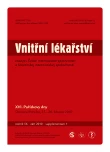Thrombocytopenia and coagulopathy in hepatopathy: an introduction into the issue
Authors:
J. Charvát
Authors‘ workplace:
Pracoviště laboratorních metod IKEM Praha, přednosta prof. MUDr. Antonín Jabor, CSc.
Published in:
Vnitř Lék 2010; 56(Supplementum 1): 66-69
Category:
16th Parizek's Days, Ostrava-Poruba, March 25th –26th 2010
Overview
The liver is the key organ for blood coagulation processes. The liver has an effect on platelet count and their quality. Additionally, it is the organ where most coagulation and fibrinolytic factors as well as their inhibitors are synthesized. Degradation of activated coagulation and fibrinolytic factors also occurs in the liver. Likewise, endogenous heparin and what is called heparin like substance may be released from the liver. Patients often do not bleed even in the presence of a substantial deficiency of procoagulation factors as this condition is associated with decreased levels of coagulation inhibitors while, in other cases, they do bleed for local causes (esophageal varices) even at relatively adequate levels of coagulation factors, or thrombocytopenia and thrombocypathy are at play. Appropriate assessment of blood coagulation status by an experienced hematologist will allow choosing a rational therapeutic option.
Key words:
liver failure – coagulation factors – coagulation inhibitors – fibrinolysis – thrombocytopathy – prothrombin time – DIC
Sources
1. Trotter JF. Coagulation abnormalities in patients who have liver disease. Clin Liver Dis 2006; 10: 665– 678.
2. Aster RH. Pooling of platelets in the speen: role in the pathogenesis of „hypersplenic“ thrombocytopenia. J Clin Invest 1966; 45: 645– 657.
3. Rios R, Sangro B, Herreto I et al. The role of thrombopoietin in the thrombocytopenia of patiens with liver cirrhosis. Am J Gastroenterol 2005; 100: 1311– 1316.
4. Nakajima H, Takagi H, Yamazaki Y et al. Immune thrombocytopenic purpura in patients with hepatitis C virus infection. Hepatogastroenterology 2005; 52: 1197– 1200.
5. Levine RF, Spivak JL, Meagher RC et al. Effect of etanol on thrombopoiesis. Br J Haematol 1986; 62: 345– 354.
6. Yoshikawa T, Nakanishi K, Maruta T et al. Anticoagulant-induced pseudothrombocytopenia occurig after transcatheter arterial embolization for hepatocellular carcinoma. Jpn J Clin Oncol 2006; 36: 527– 531.
7. Pasche B, Ouimet H, Francis S et al. Structural changes in platelet glykoprotein IIb/ IIIa by plasmin: determinants and functional consequenses. Blood 1994; 83: 404– 414.
8. Tripodi A, Primignani M, Chantarangkul V et al. Thrombin generation in patients with cirrhosis: the role of platelets. Hepatology 2006; 44: 440– 445.
9. Tripodi A, Caldwell A, Hoffman M et al. Review article: the prothrombin time test as a measure of bleeding risk and prognosis in liver disease. Aliment Pharmacol Therap 2007; 26: 141– 148.
10. Robert H, Chazouilleres O. Prothrombin time in liver failure: time, ratio, activity percentage, or international normalized ratio? Hepatology 1996; 4: 1392– 1394.
11. Reverter JC. Abnormal hemostasis tests and bleeding in chronic liver disease: are they related? Yes. J Thromb Haemost 2006; 4: 717– 720.
12. Matsushita T, Saito H. Abnormal hemostasis tests and bleeding in chronic liver disease: are they related? No, but they need a careful look. J Thromb Haemost 2006; 4: 2066– 2067.
13. Castelino DJ, Salem HH. Natural anticoagulats and the liver. J Gastroenterol Hepatol 1997; 12: 77– 83.
14. Tripodi A, Salerno F, Chantarangkul V et al. Evidence of normal thrombin generation in cirrhosis despite abnormal conventional coagulation tests. Hepatology 2005; 41: 553– 558.
15. Pernambuco JR, Langley PG, Hughes RD et al. Activation of the fibrinolytic system in patients with fulminant liver failure. Hepatology 1993; 18: 1350– 1356.
16. Ferguson JW, Helmy A, Ludlam C et al. Hyperfibrinolysis in alcoholic cirrhosis: relative plasminogen activator inhibitor type 1 deficiency. Thromb Res 2008; 121: 675– 680.
17. Vukovich T, Teufelsbauer H, Fritzer M et al. Hemostasis activation in patients with liver cirrhosis. Thromb Res 1995; 77: 271– 278.
18. Ben– Ari Z, Osman H, Hutton RA et al. Disseminated intravascular coagulation in liver cirrhosis: fact or fiction? Am J Gastroenterol 1999; 94: 2977– 2982.
19. Kujovich JL. Hemostatic defect in end stage liver disease. Crit Care Clin 2005; 21: 563– 587.
20. Northup PG, McMahon MM, Ruhl AP et al. Coagulopathy does not fully protect hospitalized cirrhosis patients from peripheral venous thromboembolism. Am J Gastroenterol 2006; 101: 1524– 1528.
21. Northup PG, Sundaram V, Fallon MB et al. Hypercoagulation and thrombophilia in liver disease. J Thromb Haemost 2008; 6: 2– 9.
22. Briere JB. Budd-Chiari syndrome and portal vein thrombosis associated with myeloproliferative disorders: diagnosis and management. Seminars in Thromb Haemost 2006; 32: 20– 218.
23. Dentali F, Galli M, Gianni D et al. Inherited thrombotic abnormalities and risk of portal vein thrombosis. A meta-analysis. Thromb Haemost 2008; 99:675– 682.
Labels
Diabetology Endocrinology Internal medicineArticle was published in
Internal Medicine

2010 Issue Supplementum 1
Most read in this issue
- Thrombocytopenia and coagulopathy in hepatopathy: an introduction into the issue
- Monitoring of coagulation parameters and options to influence them in patients with liver cirrhosis prior to invasive procedures
- Differential diagnosis of thrombocytopaenia in pregnancy
- The application of IPF (Immature platelet fraction) in laboratory diagnostics
